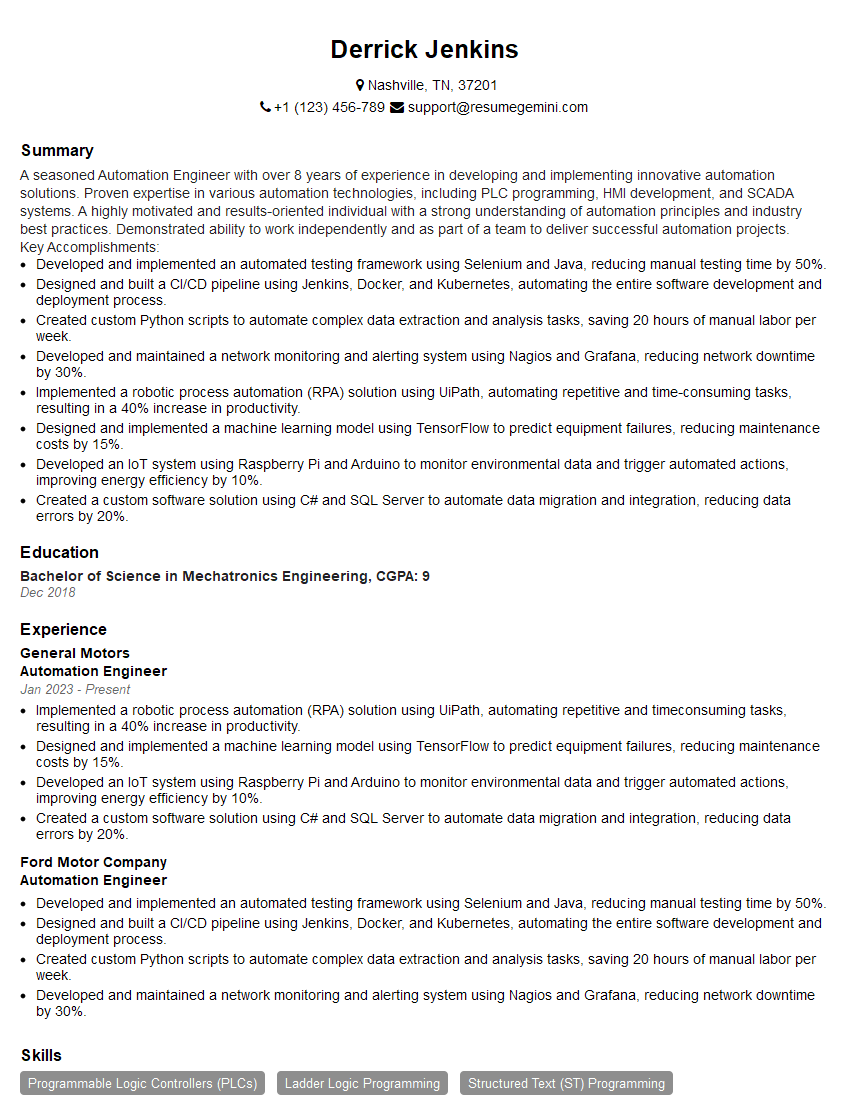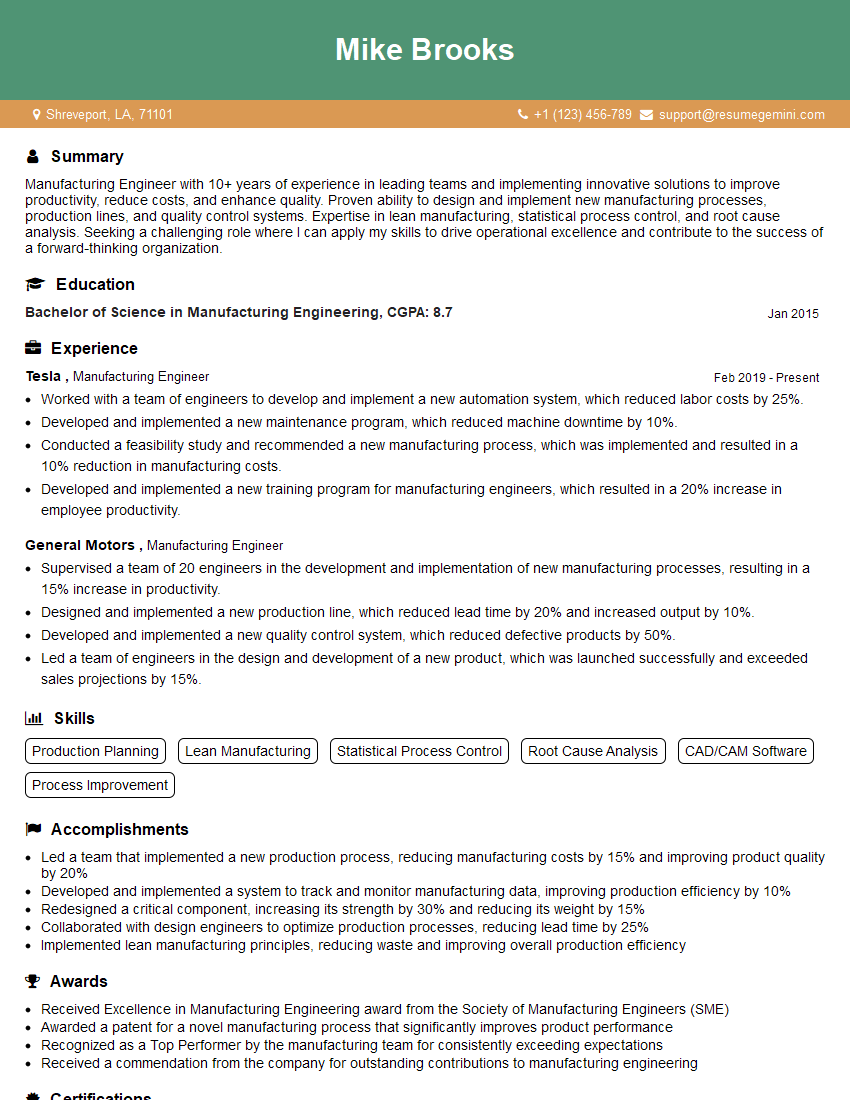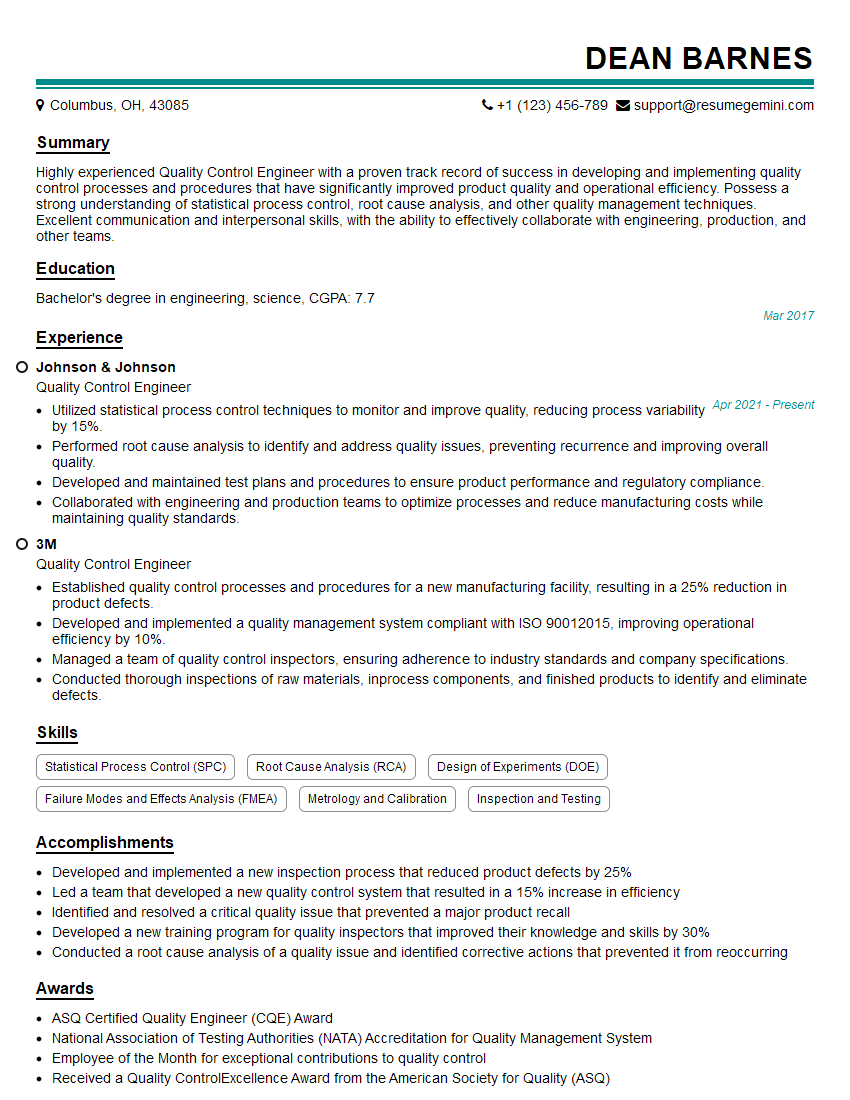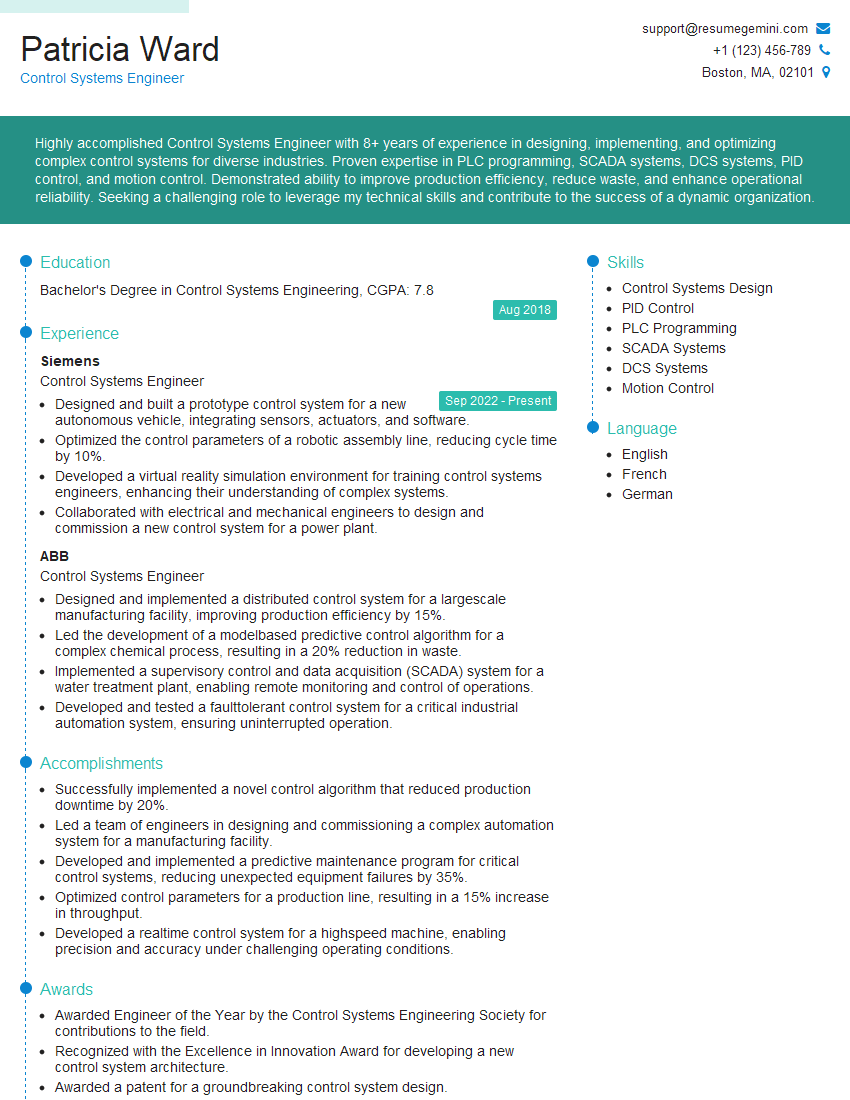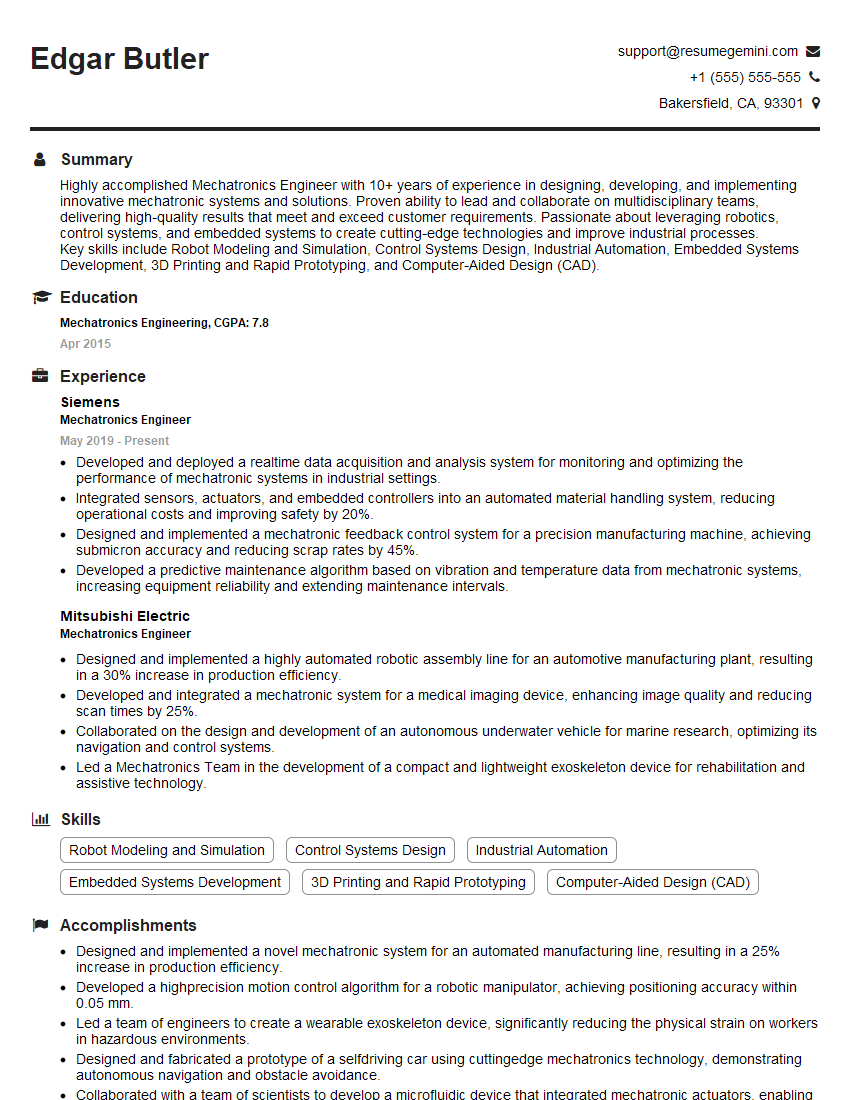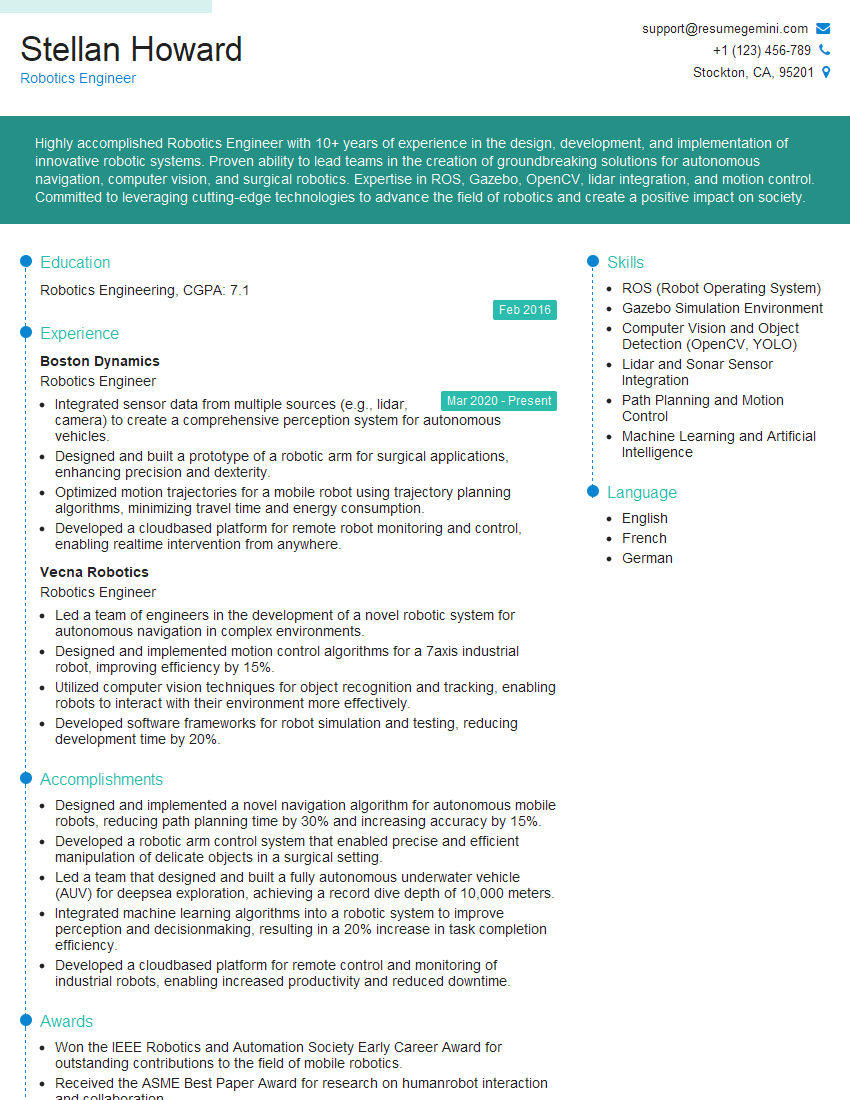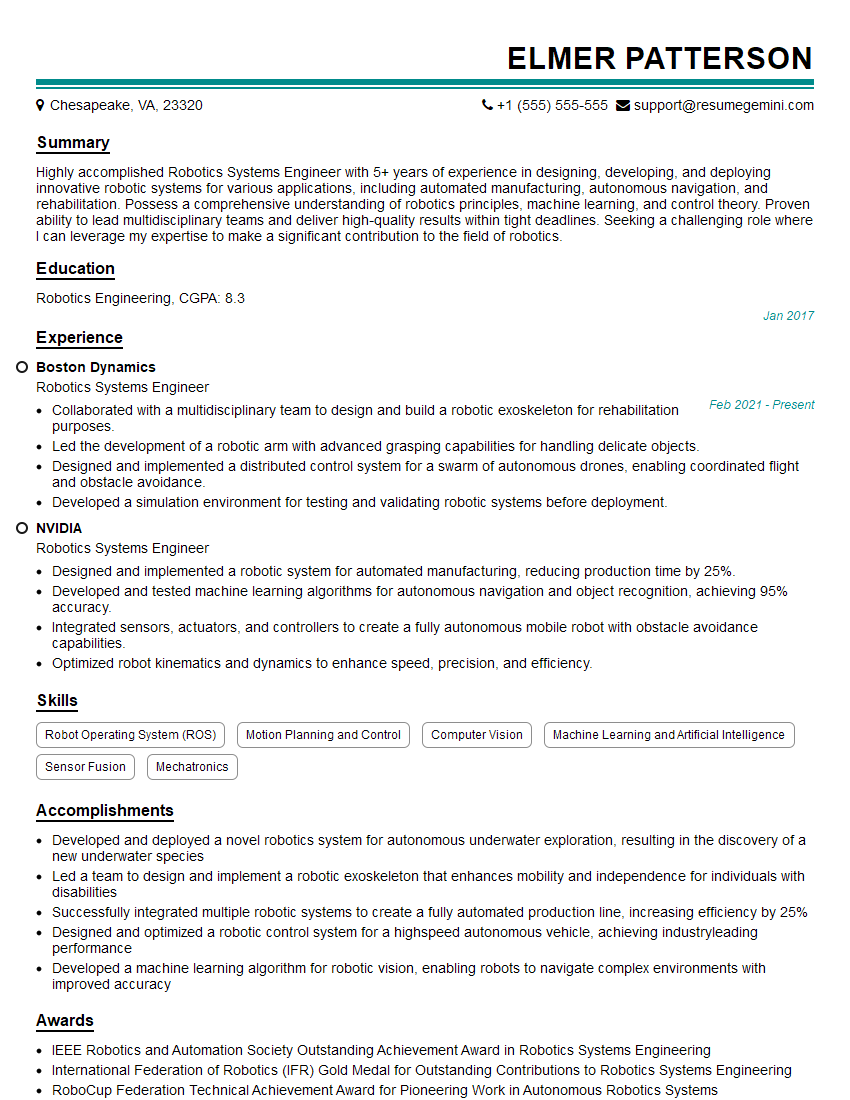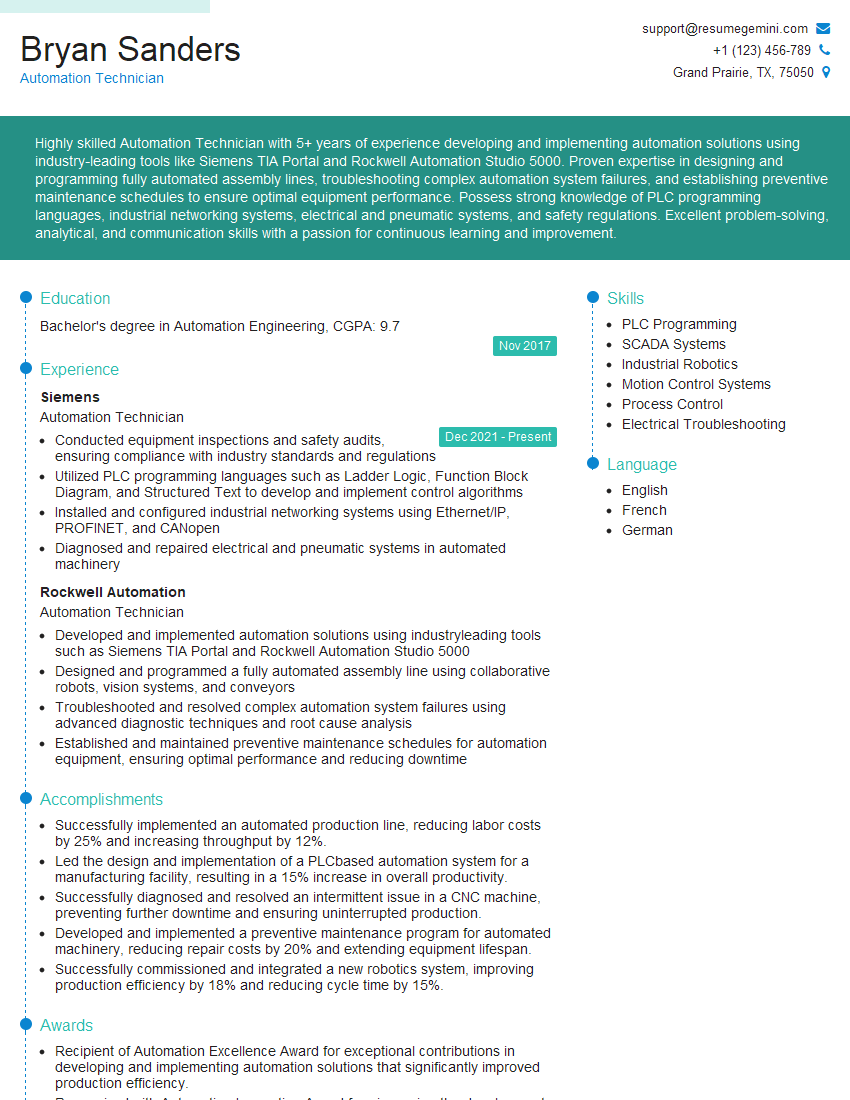Every successful interview starts with knowing what to expect. In this blog, we’ll take you through the top Robot Calibration interview questions, breaking them down with expert tips to help you deliver impactful answers. Step into your next interview fully prepared and ready to succeed.
Questions Asked in Robot Calibration Interview
Q 1. Explain the importance of robot calibration in industrial automation.
Robot calibration is crucial in industrial automation because it ensures the robot’s movements match its programmed instructions accurately. Think of it like tuning a musical instrument – without proper tuning, the music sounds off-key. Similarly, an uncalibrated robot will not perform its tasks precisely, leading to inconsistencies and potential failures. Accurate calibration guarantees the robot’s end-effector (the tool or hand at the end of the arm) reaches the designated position and orientation, vital for tasks like welding, painting, assembly, and pick-and-place operations. This translates to improved product quality, increased productivity, and reduced waste.
In essence, calibration bridges the gap between the robot’s theoretical model and its real-world behavior, making it a reliable and efficient part of the automation process.
Q 2. Describe different robot calibration methods (e.g., hand-eye, self-calibration).
Several methods exist for robot calibration, each with its strengths and weaknesses.
- Hand-eye calibration: This technique determines the transformation between the robot’s base coordinate system and a camera’s coordinate system. Imagine a robotic arm trying to pick up an object detected by a camera. Hand-eye calibration ensures the robot knows precisely where the camera sees the object relative to its own position, allowing it to accurately grasp the item. This often involves using a calibration target with known geometry.
- Self-calibration: This method relies on the robot’s internal sensors and its movements to estimate its kinematic parameters. The robot moves in a planned way, and by comparing its actual movement with the intended movement, it calculates and corrects errors in its model. It’s like the robot learning its own limitations and compensating for them, thereby improving its accuracy.
- External measurement systems: Techniques like laser trackers or other high-precision measuring devices provide external measurements of the robot’s position and orientation during calibration. This external reference improves accuracy. It’s like having a highly skilled inspector double-checking the robot’s actions.
- Workspace calibration: This approach focuses on calibrating the robot’s accuracy within its specific workspace, rather than aiming for global accuracy across its entire range of motion. This is especially useful in scenarios where the robot primarily operates within a limited area.
The choice of method depends on factors such as the robot’s design, the application’s precision requirements, and the available equipment.
Q 3. What are the common sources of errors in robot calibration?
Errors in robot calibration stem from various sources. Here are some of the most common:
- Mechanical inaccuracies: Manufacturing tolerances in the robot’s links, joints, and actuators lead to deviations from the ideal geometry. Think of slight imperfections in the robot’s construction.
- Gear backlash and friction: The play in gears and the friction in joints cause inconsistent movements. It’s similar to the slight slop you might feel in a worn-out door hinge.
- Thermal effects: Temperature changes can cause the robot’s links to expand or contract, affecting its geometry. This is especially important in industrial environments with varying temperatures.
- Sensor noise: Imperfections in the robot’s encoders (which measure joint angles) and other sensors introduce noise into the measurements, affecting calibration accuracy.
- Software errors: Programming errors or limitations in the robot’s control software can contribute to calibration inaccuracies. This is the ‘human error’ component of the calibration process.
- External forces and disturbances: External factors such as vibrations or collisions can affect the robot’s position and consequently, its calibration.
Q 4. How do you identify and diagnose calibration errors?
Identifying and diagnosing calibration errors requires a systematic approach. It starts by analyzing the robot’s performance.
- Repeatability tests: The robot repeatedly attempts to reach a specific point. High deviations between attempts indicate calibration issues.
- Accuracy tests: The robot’s actual position is compared with its commanded position using external measuring equipment. Discrepancies highlight areas needing attention.
- Error mapping: This involves systematically measuring the robot’s errors at different points in its workspace, which creates a detailed picture of its inaccuracies. This is like creating a map of the robot’s errors.
- Statistical analysis: Statistical methods help analyze the collected data to identify patterns and sources of error. This allows for focused adjustments.
Once errors are identified, the specific source needs to be investigated. This may involve visual inspection of mechanical components, checking sensor readings, reviewing control software, or even recalibrating individual sensors or components.
Q 5. What are the effects of inaccurate robot calibration on production?
Inaccurate robot calibration significantly impacts production in several ways:
- Reduced product quality: Inconsistent positioning leads to errors in welding, painting, or assembly, resulting in defective products. Imagine a robotic welder missing its target by even a fraction of a millimeter – the weld might be weak or flawed.
- Increased scrap and rework: Defective products must be scrapped or reworked, increasing costs and reducing throughput. This translates to direct financial losses.
- Lower productivity: The need for frequent intervention to correct errors slows down the production process, decreasing overall efficiency.
- Increased downtime: Major calibration errors can bring the entire production line to a standstill, resulting in significant downtime and lost revenue. This impacts the entire production schedule.
- Safety hazards: Inaccurate movements can lead to collisions with equipment or personnel, posing safety risks.
Q 6. Explain the concept of kinematic calibration.
Kinematic calibration focuses on correcting errors in the robot’s geometric model. This model describes the robot’s physical structure and the relationships between its links and joints. Think of it as creating an accurate blueprint of the robot’s physical form. Inaccurate kinematic parameters lead to positioning errors. Kinematic calibration involves determining the precise lengths of the robot’s links, the angles between the joints, and the locations of the joints relative to each other. This process typically uses measurement data obtained via various techniques (like those discussed in question 2) to refine the robot’s model, improving its positional accuracy.
For instance, slight variations in link lengths during manufacturing can be accounted for through kinematic calibration. This ensures the robot’s actual movements align with its programmed commands.
Q 7. Explain the concept of dynamic calibration.
Dynamic calibration focuses on compensating for non-geometric errors that influence the robot’s movement, such as friction, inertia, and gear backlash. While kinematic calibration focuses on the robot’s structure, dynamic calibration refines the robot’s dynamic model, which describes its behavior under different loads and velocities. It is like tuning the ‘engine’ of the robot.
For example, dynamic calibration adjusts for the changes in the robot’s movement caused by variations in payload weight or speed. This involves identifying and modeling the effects of dynamic parameters on the robot’s response and incorporating these models into the control algorithms. The resulting improvement in the robot’s responsiveness and accuracy contributes to smoother operations and increased precision, especially in high-speed applications.
Q 8. What software and tools are commonly used for robot calibration?
Robot calibration software and tools vary depending on the robot manufacturer and the specific application. However, some common choices include:
- Manufacturer-Specific Software: Most robot manufacturers (like ABB RobotStudio, FANUC ROBOGUIDE, KUKA.WorkVisual) provide their own software packages. These are often integrated development environments (IDEs) that allow for programming, simulation, and calibration. They often have built-in calibration wizards which simplify the process.
- Calibration Software Packages: Independent software packages exist that can handle calibration across different robot brands. These often provide more flexible analysis and reporting capabilities.
- Measurement Systems: Accurate measurement systems are crucial. This includes laser trackers, photogrammetry systems, and CMMs (Coordinate Measuring Machines). These provide the precise positional data needed for calibration.
- Data Acquisition Tools: Specialized hardware and software are often used to collect data from the robot during the calibration process. This can involve custom interfaces or pre-built systems designed to interface with the robot’s control system.
For example, in a recent project involving a six-axis FANUC robot, we utilized the ROBOGUIDE software for initial simulation and planning, then used a Leica laser tracker to collect measurement data during the actual calibration. This provided high-accuracy positional data for refining the robot’s kinematic model.
Q 9. How do you ensure the accuracy and repeatability of calibration?
Ensuring accuracy and repeatability in robot calibration requires a multi-faceted approach:
- Precise Measurement Techniques: Utilizing high-precision measurement devices like laser trackers, and ensuring proper setup and calibration of these tools themselves is paramount. Any error in the measurement system directly propagates into the robot’s calibration.
- Redundant Measurements: Taking multiple measurements at various points and orientations helps reduce the influence of individual measurement errors. Statistical analysis can then identify and mitigate outliers.
- Robust Calibration Methods: Employing sophisticated calibration algorithms, such as those based on least-squares optimization or other robust estimation techniques, is essential. These algorithms can handle noisy data and minimize the impact of measurement errors.
- Environmental Control: Maintaining a stable temperature and minimizing vibrations in the workspace reduces environmental influences on measurements and robot performance.
- Regular Calibration Checks: Performing regular calibration checks and updates is essential to maintain accuracy over time. The frequency depends on factors like usage and environmental conditions.
Think of it like tuning a musical instrument: repeated fine-tuning (calibration) is necessary to ensure consistent and accurate performance. In our work, we often use statistical process control (SPC) charts to monitor calibration stability over time and detect potential drift.
Q 10. Describe your experience with different robot brands and their calibration procedures.
My experience spans several robot brands, including ABB, FANUC, KUKA, and Universal Robots (UR). Each brand has its own unique calibration procedures and software:
- ABB: ABB’s RobotStudio provides a comprehensive environment for calibration and simulation. Their procedures often involve using a laser tracker to collect data points and then using the software to refine the kinematic model.
- FANUC: FANUC’s ROBOGUIDE software is similarly comprehensive, enabling simulations and calibration routines. They often incorporate internal calibration routines, meaning the robot itself performs self-diagnostic steps.
- KUKA: KUKA’s KUKA.WorkVisual offers a comparable integrated environment. Their calibration procedures can involve both internal and external calibration techniques.
- Universal Robots (UR): UR robots are known for their relative ease of use, and their calibration procedures are often simpler. They usually involve a user-guided process using the robot’s teach pendant, focusing more on end-effector calibration.
The key difference isn’t necessarily in the *fundamental principles* of calibration, but rather in the specific software, tools, and interfaces provided by each manufacturer. The underlying goal remains the same: achieving high accuracy and repeatability. For instance, while a FANUC robot might emphasize internal self-diagnostics, an ABB might require more external measurement tools.
Q 11. What is the difference between internal and external calibration?
Internal and external calibration refer to different approaches to modeling and correcting robot inaccuracies:
- Internal Calibration: This involves using sensors and internal measurements within the robot itself to estimate and compensate for errors in the robot’s kinematics. The robot’s own sensors (encoders, resolvers) provide information used in the calibration process. This is often a factory procedure but some robots allow limited adjustments through their software.
- External Calibration: This uses external measurement devices (like laser trackers or CMMs) to precisely measure the robot’s end-effector position and orientation at various points in the workspace. This data is then used to build or refine a kinematic model that better represents the robot’s actual behavior. This is often necessary for higher accuracy applications or after significant changes (e.g., end-effector replacement).
Imagine internal calibration as self-adjusting your own posture to correct minor imbalances. External calibration is like someone else observing your posture and providing specific feedback to improve your alignment. External calibration usually offers higher accuracy and is a more thorough approach.
Q 12. How do you handle unexpected calibration issues during production?
Unexpected calibration issues during production require a systematic troubleshooting approach:
- Identify the Issue: Precisely determine the nature of the problem. Is it a sudden drop in accuracy, inconsistent performance, or a specific error message? This might require analyzing error logs, sensor readings, and the robot’s operational data.
- Isolate the Cause: Determine the root cause. Is it related to the robot’s mechanics (wear and tear, loose components), software issues, environmental factors (temperature fluctuations, vibrations), or errors in the calibration process itself?
- Implement Corrective Actions: Based on the identified cause, take the appropriate corrective action. This may involve re-calibration, component replacement, software updates, or adjustments to the work environment.
- Monitor and Validate: After implementing corrective actions, closely monitor the robot’s performance to ensure the issue is resolved. Perform further calibration checks to verify accuracy and repeatability.
- Document and Prevent Future Issues: Document the entire troubleshooting process, including the cause, corrective actions, and preventative measures. This helps in identifying and avoiding similar problems in the future.
A recent example involved a sudden accuracy drop in a packaging robot. Through systematic analysis, we traced it to a slightly loose joint in the robot arm. Tightening the joint and performing a recalibration completely resolved the problem.
Q 13. What safety precautions do you take during robot calibration?
Safety is paramount during robot calibration. Here are some key precautions:
- Emergency Stop Procedures: Ensure easy access to the emergency stop button and understand its function. Regular testing of the emergency stop system is necessary.
- Robot Power-Down: Power down the robot completely before performing any manual adjustments or interventions. This prevents accidental movements and minimizes risk of injury.
- Restricted Access: Restrict access to the robot’s work area during calibration to prevent accidental entry by unauthorized personnel.
- Appropriate PPE: Wear appropriate personal protective equipment (PPE), including safety glasses and gloves.
- Risk Assessment: Conduct a thorough risk assessment before commencing any calibration work. This helps identify and mitigate potential hazards.
- Lockout/Tagout Procedures: Implement lockout/tagout procedures to prevent accidental activation of the robot during maintenance or calibration activities.
We always adhere to strict safety protocols. Prior to every calibration job, we have a comprehensive safety briefing, and we implement lockout/tagout procedures to prevent unexpected robot movement. Our work is guided by relevant safety standards and company regulations.
Q 14. Explain your understanding of error propagation in robot calibration.
Error propagation in robot calibration refers to how uncertainties in measurements and model parameters accumulate and affect the overall accuracy of the calibrated robot model. Errors in individual measurements, such as those from the laser tracker, are not isolated events, but influence the accuracy of the entire calibration.
Consider a simplified example: If you have a small error in measuring the position of a single calibration point, that error will affect the estimation of the robot’s kinematic parameters. Those parameter errors will then propagate to predictions of the robot’s position and orientation at other points in its workspace.
Therefore, understanding error propagation is crucial for:
- Uncertainty Quantification: Estimating the uncertainty associated with the calibrated robot model. This allows for a realistic assessment of the robot’s accuracy and reliability.
- Optimization of Calibration Strategy: Selecting appropriate measurement locations and methods to minimize error propagation. For instance, well-distributed measurement points can often reduce the influence of errors in individual measurements.
- Improving Calibration Accuracy: Implementing techniques to reduce errors during measurements, using robust estimation algorithms, and improving the precision of the calibration equipment.
Advanced calibration techniques, such as those incorporating covariance matrices and statistical analysis, are employed to handle error propagation effectively. We routinely use such methods to evaluate the uncertainty in our robot calibrations and communicate the limits of accuracy to our clients.
Q 15. How do you document and manage calibration procedures?
Comprehensive documentation of robot calibration procedures is crucial for reproducibility, traceability, and efficient troubleshooting. My approach involves a multi-layered system combining detailed written procedures, digital records, and version control.
- Written Procedures: I create step-by-step guides detailing each calibration stage, including equipment setup, software configurations, measurement techniques, and data analysis methods. These are written clearly and concisely, using diagrams and flowcharts to aid understanding. They specify tolerances, acceptance criteria, and corrective actions for deviations.
- Digital Records: All calibration data—sensor readings, transformation matrices, error reports—are stored in a secure, version-controlled database. This allows for easy retrieval of past calibration results and facilitates trend analysis to identify potential issues over time. We utilize a system with robust backup and recovery mechanisms.
- Calibration Certificates: Upon completion, a certificate is generated, detailing the robot’s identification, calibration date, results, and the technician’s signature. This official document serves as proof of calibration and ensures compliance with relevant safety and quality standards.
- Version Control: Any modifications to the calibration procedures are meticulously tracked, ensuring that the latest version is always accessible. This prevents confusion and allows for easy rollback if needed.
For example, in a recent automotive assembly application, detailed documentation allowed us to quickly diagnose and correct a calibration drift issue by comparing current data against historical records, pinpointing a change in environmental conditions as the root cause.
Career Expert Tips:
- Ace those interviews! Prepare effectively by reviewing the Top 50 Most Common Interview Questions on ResumeGemini.
- Navigate your job search with confidence! Explore a wide range of Career Tips on ResumeGemini. Learn about common challenges and recommendations to overcome them.
- Craft the perfect resume! Master the Art of Resume Writing with ResumeGemini’s guide. Showcase your unique qualifications and achievements effectively.
- Don’t miss out on holiday savings! Build your dream resume with ResumeGemini’s ATS optimized templates.
Q 16. Describe your experience with laser trackers or other measurement systems used in robot calibration.
I have extensive experience using laser trackers and photogrammetry systems for high-precision robot calibration. These systems offer superior accuracy compared to traditional methods, enabling the precise measurement of robot end-effector pose across its entire workspace.
- Laser Trackers: I’ve utilized Leica AT401 and FARO Vantage laser trackers to capture the 3D coordinates of calibration targets affixed to the robot end-effector. The high accuracy and long range of these systems allow for calibration across large workspaces, minimizing the need for multiple setups. The data is processed using specialized software to compute the robot’s kinematic parameters.
- Photogrammetry Systems: For situations where laser trackers might be impractical (e.g., due to environmental limitations), I’ve successfully employed photogrammetry using multiple high-resolution cameras. This technique involves capturing images of calibration targets from different viewpoints and utilizing software to reconstruct the 3D model and determine target positions. While less precise than laser trackers in some cases, this method offers flexibility and cost-effectiveness in specific applications.
For instance, in a recent project involving a large robotic arm used for welding, the laser tracker’s long range allowed us to calibrate the robot’s entire workspace without needing to move the tracker, significantly reducing the calibration time and cost.
Q 17. How do environmental factors (temperature, humidity) affect robot calibration?
Environmental factors such as temperature and humidity significantly impact robot calibration accuracy. Changes in these conditions can cause thermal expansion and contraction of robot components, leading to geometrical deviations and positional errors.
- Temperature Effects: Temperature variations affect the length of robot links and the accuracy of encoders and other sensors. This can lead to systematic errors in robot positioning. To mitigate this, temperature-controlled environments or robust thermal compensation models are often necessary.
- Humidity Effects: High humidity can cause swelling and deformation of certain robot components, particularly those made of composite materials. This can affect the robot’s geometry and kinematic parameters. Maintaining a stable humidity level is therefore crucial for consistent calibration.
A practical example: In a paint application, where precise positioning is critical, even small temperature fluctuations can result in inconsistent paint application. We addressed this by implementing a temperature-controlled spray booth and incorporating a thermal compensation algorithm in the robot’s control software.
Q 18. How do you validate the accuracy of your calibration?
Validation of robot calibration accuracy is a critical step to ensure that the calibration process has been successful and the robot is performing within acceptable tolerances. This usually involves comparing the robot’s actual pose to its commanded pose at multiple points throughout its workspace.
- Repeatability Tests: Repeatedly commanding the robot to the same position and measuring the actual position provides a measure of repeatability. This test highlights the robot’s consistency in returning to the same location.
- Accuracy Tests: Measuring the difference between the commanded and actual positions at various points across the robot’s workspace provides a measure of accuracy. This assessment helps determine the overall accuracy of the robot’s movements.
- Residual Error Analysis: After calibration, a residual error analysis is performed. This involves analyzing the difference between the measured and predicted robot poses. Large residuals indicate areas where the calibration may be inadequate and require further attention.
If the measured errors exceed the predefined acceptance criteria, the calibration process needs to be reviewed, and potential sources of error (e.g., faulty sensors, inaccurate models) need to be investigated and corrected. This might involve re-calibration, or even identifying and resolving mechanical issues within the robot itself.
Q 19. What are the key performance indicators (KPIs) for robot calibration?
Key Performance Indicators (KPIs) for robot calibration focus on quantifying the accuracy and repeatability of the robot’s movements after the calibration process. These KPIs guide improvement efforts and ensure the robot meets required performance standards.
- Accuracy: Measured as the difference between the commanded and actual position of the robot’s end-effector. This is usually expressed as a positional error (e.g., in millimeters or degrees).
- Repeatability: Measures the robot’s consistency in returning to the same position multiple times. It’s often defined as the standard deviation of multiple measurements at the same commanded position.
- Calibration Time: The total time required for the calibration procedure. This KPI is important for maximizing productivity and minimizing downtime.
- Calibration Cost: The overall cost associated with the calibration process, including equipment, personnel, and materials.
By tracking these KPIs over time, we can identify trends, optimize calibration procedures, and assess the effectiveness of different calibration strategies. A continuous improvement approach, driven by KPI monitoring, is essential for maintaining high robot performance.
Q 20. Describe your experience with different calibration targets and their selection criteria.
The selection of calibration targets is critical for obtaining accurate and reliable calibration results. The choice depends on the robot’s workspace, the required accuracy, and the available measurement system.
- Spherical Targets: Commonly used due to their ease of identification and measurement by laser trackers. They offer a high degree of accuracy and are suitable for large workspaces.
- Planar Targets: Useful for calibrating robots with limited workspace or for situations where the robot’s movement is predominantly planar.
- Retroreflective Targets: Used with laser trackers, these targets enhance the accuracy of measurements by maximizing the reflected laser signal.
- Target Spacing and Distribution: Targets should be strategically placed across the robot’s workspace to capture the full range of movements. The spacing between targets should be optimized to balance accuracy and efficiency.
For example, in a small-scale assembly application, we might use planar targets with a dense spacing to ensure high accuracy in a restricted area. In contrast, for a large painting robot, we would use spherical retroreflective targets distributed throughout the workspace to capture the entire range of its movements.
Q 21. How do you troubleshoot calibration problems related to software issues?
Troubleshooting software-related calibration problems requires a systematic approach, combining careful observation, methodical testing, and an understanding of the robot’s software architecture.
- Log File Analysis: Examining the robot’s log files can provide valuable clues about the source of the problem. Errors, warnings, and unexpected behavior can be identified and analyzed to pinpoint the faulty component or process.
- Software Version Check: Ensuring that the robot’s software, drivers, and calibration software are up-to-date and compatible is critical. Outdated software can introduce bugs and inconsistencies.
- Sensor Data Verification: Inspecting the raw data from sensors (encoders, resolvers) can identify potential issues with sensor calibration or hardware faults. This step often involves comparing sensor readings with expected values.
- Simulation and Modeling: Using a robot simulator to reproduce the calibration process can help isolate software errors and identify potential conflicts in the software configuration. Debugging and testing in a simulated environment minimizes the risk of damaging the actual robot.
For instance, in one project, a seemingly inexplicable calibration error was traced to a mismatch between the robot’s software configuration and the firmware version of the controller. A simple software update resolved the problem.
Q 22. Explain your understanding of coordinate systems and transformations in robot calibration.
Understanding coordinate systems and transformations is fundamental to robot calibration. Robots operate in multiple coordinate systems: the base coordinate system (fixed to the robot’s base), the tool coordinate system (attached to the end-effector), and joint coordinate systems (associated with each robot joint). Calibration involves accurately determining the relationships between these systems. This relationship is represented by mathematical transformations, typically homogeneous transformations, which are 4×4 matrices.
These transformations describe how to move a point from one coordinate system to another. They incorporate translation (moving the origin) and rotation (changing orientation). For example, a transformation might specify that a point at (1, 0, 0) in the base frame is located at (2, 1, 0.5) in the tool frame, along with a specific rotation. Accurate calibration ensures that the robot’s controller can correctly map commands (joint angles) to the actual end-effector position and orientation in the workspace.
Consider a pick-and-place application. If the transformations are incorrect, the robot might try to grasp an object at a location that’s slightly off, resulting in a failed operation. Calibration minimizes such errors.
Q 23. How would you approach calibrating a robot arm with six degrees of freedom?
Calibrating a six-degrees-of-freedom (6-DOF) robot arm requires a systematic approach. I’d typically employ a combination of methods, starting with kinematic calibration, followed by dynamic calibration if higher precision is needed.
- Kinematic Calibration: This focuses on the geometrical parameters of the robot, such as link lengths, joint offsets, and twist angles. I would use a method like the Least-Squares method or a more advanced optimization algorithm, employing a set of precisely measured points in the robot’s workspace. The robot would be commanded to specific poses, and the actual positions would be compared to the commanded positions. This data would be used to estimate the kinematic parameters, minimizing the difference between commanded and actual poses. Measurement tools like laser trackers or vision systems are crucial for this stage.
- Dynamic Calibration: If required, this step would model the robot’s dynamics (inertia, friction, etc.). This would use more sophisticated techniques, possibly involving system identification methods and analyzing the robot’s response to various inputs. Dynamic calibration is often needed for high-speed or high-precision applications where dynamic effects become significant.
The entire process involves iterative refinement, careful error analysis, and verification. The goal is to achieve a level of accuracy that meets the specific application’s requirements.
Q 24. What is your experience with robotic vision systems and their integration with calibration?
Robotic vision systems are invaluable for robot calibration, significantly enhancing accuracy and efficiency. They allow for non-contact measurement of the robot’s end-effector position and orientation. I have extensive experience integrating vision systems into calibration procedures, primarily using structured light systems and camera calibration techniques.
For example, in one project, we utilized a structured light sensor to capture 3D point clouds of calibration targets placed within the robot’s workspace. This data, processed through camera calibration algorithms (such as those based on OpenCV libraries), provided precise position data of the targets. This data was then used in a kinematic calibration algorithm to refine the robot’s kinematic model. Using vision systems enables the measurement of numerous points across the workspace which significantly increases accuracy and robustness compared to traditional methods.
Integration involves careful consideration of factors such as camera placement, lighting conditions, and the processing speed of the vision system, to ensure compatibility with the calibration method and minimize errors introduced by the vision system itself.
Q 25. Describe a challenging robot calibration project you worked on and how you overcame it.
One challenging project involved calibrating a large industrial robot arm used in an automotive assembly line. The robot was operating in a challenging environment with significant thermal variations. This caused significant drift in the robot’s pose over time, leading to inaccuracies in the assembly process. Standard kinematic calibration techniques were insufficient.
To overcome this, we implemented a real-time calibration approach. We used temperature sensors integrated into the robot’s structure to monitor temperature changes. We then developed a model that correlated these temperature changes with the robot’s positional drift. This model was incorporated into the robot’s control system, making real-time adjustments to compensate for the thermal effects. This adaptive approach ensured significantly higher accuracy throughout the robot’s operational lifespan.
This required careful experimentation, data analysis, and iterative model refinement. The project highlighted the importance of considering environmental factors when designing a calibration strategy.
Q 26. What are the advantages and disadvantages of different robot calibration methods?
Various robot calibration methods exist, each with advantages and disadvantages.
- Analytical methods (e.g., using geometric relationships) are simpler to implement but might be less accurate, particularly for robots with complex kinematics or significant mechanical inaccuracies.
- Numerical methods (e.g., least squares or more advanced optimization techniques) can handle more complex models and achieve greater accuracy but require significant computational resources and can be sensitive to the quality of measurement data.
- Self-calibration methods leverage the robot’s movement to estimate the parameters but can be sensitive to initial guesses and noise.
The choice of method depends on the robot’s complexity, the desired accuracy, available resources, and the specific application. For example, a simpler analytical method might be sufficient for a low-precision application, whereas a sophisticated numerical approach might be necessary for a high-precision robotic surgery system.
Q 27. How do you stay updated with the latest advancements in robot calibration technologies?
Staying updated in the field of robot calibration is crucial. I actively engage in several strategies:
- Reading scientific literature: I regularly review journals such as the IEEE Transactions on Robotics and Robotics and Automation Letters, focusing on papers addressing new calibration methods and technologies.
- Attending conferences and workshops: I attend conferences like the IEEE International Conference on Robotics and Automation (ICRA) to learn about the latest advancements and network with researchers and industry professionals.
- Online courses and tutorials: I leverage online platforms like Coursera and edX to enhance my expertise in relevant areas like computer vision, optimization, and control systems.
- Industry networking: I participate in industry forums and groups to stay abreast of practical challenges and industry best practices.
This multi-faceted approach ensures that my knowledge and skillset remain current and relevant.
Q 28. What are your salary expectations for a Robotics Calibration Engineer role?
My salary expectations for a Robotics Calibration Engineer role are in the range of $90,000 to $130,000 per year, depending on factors such as location, company size, experience, and specific responsibilities. This range reflects my expertise and experience in the field.
Key Topics to Learn for Robot Calibration Interview
- Kinematic Calibration: Understanding robot arm geometry, joint parameters, and their impact on accuracy. Practical application: Troubleshooting positional errors by analyzing kinematic models and adjusting parameters.
- Dynamic Calibration: Analyzing the robot’s dynamic behavior, including inertia, friction, and gravity effects. Practical application: Optimizing robot motion for speed and precision by compensating for dynamic forces.
- Sensor Integration and Calibration: Working with various sensors (e.g., encoders, force/torque sensors) and understanding their calibration processes to ensure accurate data acquisition. Practical application: Implementing sensor fusion techniques for improved robot positioning and control.
- Calibration Methods: Familiarity with different calibration techniques (e.g., least-squares estimation, iterative methods). Practical application: Selecting and applying the most appropriate calibration method based on the specific robot and application.
- Error Modeling and Compensation: Understanding different types of errors (systematic, random) and implementing strategies for error compensation. Practical application: Developing and implementing algorithms to minimize the impact of errors on robot performance.
- Software and Programming for Calibration: Proficiency in relevant software and programming languages used for robot calibration and control (e.g., ROS, MATLAB). Practical application: Developing and implementing calibration routines and algorithms.
- Troubleshooting and Diagnostics: Identifying and resolving common calibration issues. Practical application: Diagnosing and fixing issues related to sensor inaccuracies, mechanical misalignments, or software bugs.
Next Steps
Mastering robot calibration opens doors to exciting opportunities in automation, manufacturing, and robotics research. A strong understanding of these principles is highly valued by employers. To significantly increase your chances of landing your dream role, focus on building a compelling, ATS-friendly resume that showcases your skills and experience effectively. ResumeGemini is a trusted resource that can help you craft a professional and impactful resume. They even provide examples of resumes tailored to the Robot Calibration field. Invest the time to create a resume that stands out – it’s a crucial step in your career journey.
Explore more articles
Users Rating of Our Blogs
Share Your Experience
We value your feedback! Please rate our content and share your thoughts (optional).
What Readers Say About Our Blog
Hi, I have something for you and recorded a quick Loom video to show the kind of value I can bring to you.
Even if we don’t work together, I’m confident you’ll take away something valuable and learn a few new ideas.
Here’s the link: https://bit.ly/loom-video-daniel
Would love your thoughts after watching!
– Daniel
This was kind of a unique content I found around the specialized skills. Very helpful questions and good detailed answers.
Very Helpful blog, thank you Interviewgemini team.
